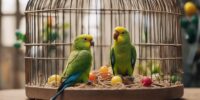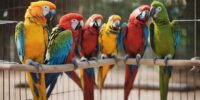What Environmental Changes Threaten Parrot Species the Most?
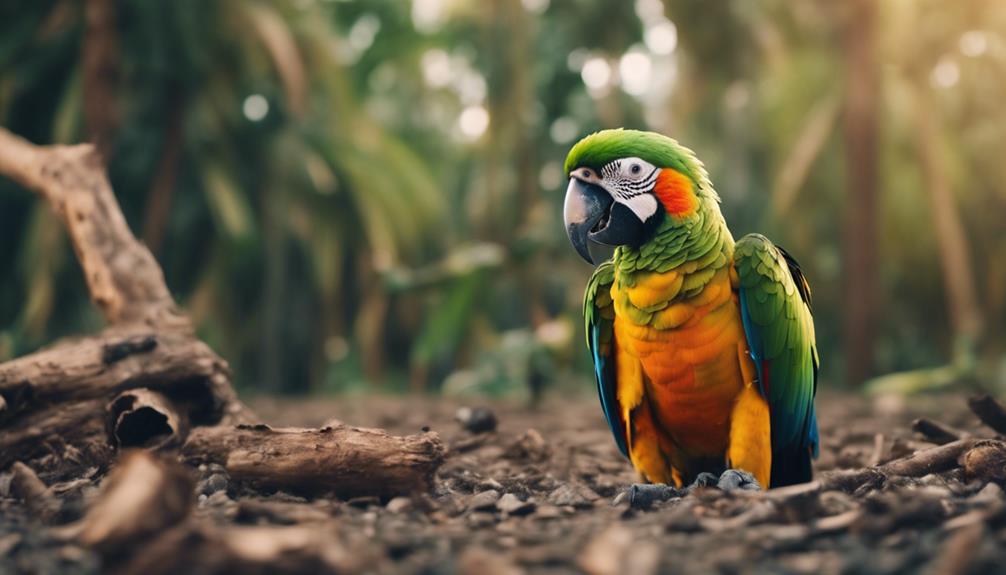
Environmental changes such as deforestation, climate change, illegal wildlife trade, pollution, invasive species, extreme weather events, hunting, and poaching pose the greatest threats to parrot species.
The urgency to address and mitigate these risks is increasingly pressing as the well-being of these vibrant birds hangs in the balance.
Deforestation and Habitat Loss
Deforestation and habitat loss pose significant threats to parrot species worldwide, leading to declines in populations and biodiversity. Logging practices and agricultural expansion are the primary drivers of these detrimental processes. Logging, whether for timber or to clear land for agriculture, results in the destruction of vital forest habitats that many parrot species depend on for nesting, foraging, and shelter. The removal of trees not only directly eliminates nesting sites but also disrupts the intricate ecosystem balance that parrots rely on for survival.
Agricultural expansion further compounds the issue by converting diverse forest areas into monoculture landscapes, which are unsuitable for most parrot species. The expansion of plantations and farmlands leads to fragmentation of remaining habitats, isolating populations and reducing genetic diversity. This fragmentation also increases the vulnerability of parrot species to other threats such as poaching and predation. Addressing these challenges requires a multi-faceted approach that involves sustainable land management practices, habitat restoration efforts, and strict regulation of logging and agricultural activities in parrot habitats.
Climate Change Impacts
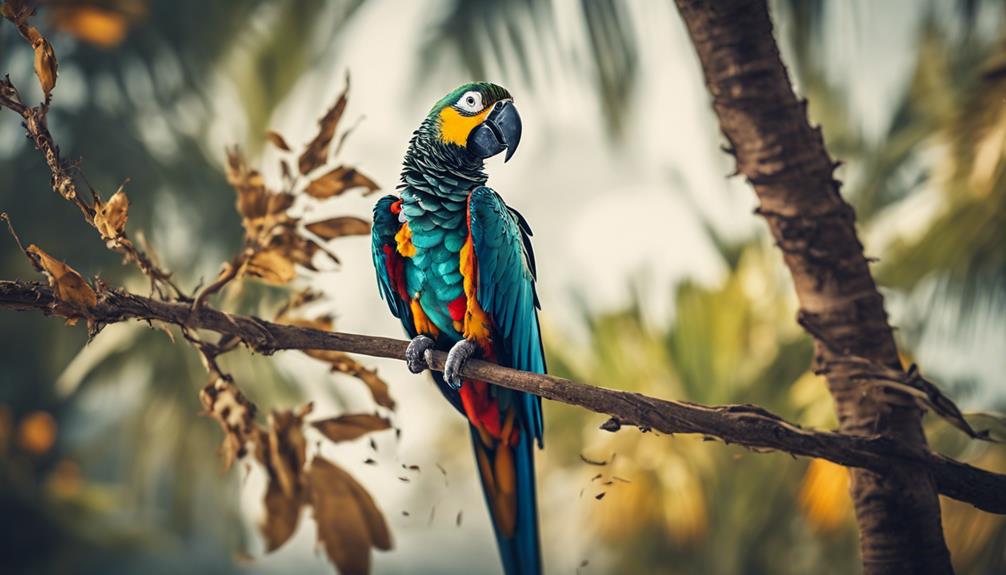
The changing climate patterns pose a growing threat to parrot species globally, impacting their habitats and survival strategies. Climate change affects parrot populations in various ways:
- Shifts in Habitat: Rising temperatures and altered precipitation patterns force parrots to adapt to new environments, affecting their food sources and nesting sites.
- Increased Frequency of Extreme Weather Events: Severe storms and heatwaves can destroy parrot habitats, leading to population declines.
- Changes in Food Availability: Climate change disrupts the availability of fruits, seeds, and other food sources that parrots rely on for nutrition.
- Spread of Diseases: Warmer temperatures can facilitate the spread of diseases among parrot populations, impacting their overall health and survival.
- Disruption of Breeding Cycles: Changing climate conditions can affect the timing of breeding seasons, leading to mismatches with food availability and reducing breeding success rates.
To address these challenges, conservation strategies must focus on protecting and restoring parrot habitats, implementing measures to enhance species adaptation to changing climates, and monitoring population responses to climate-related threats.
Illegal Wildlife Trade
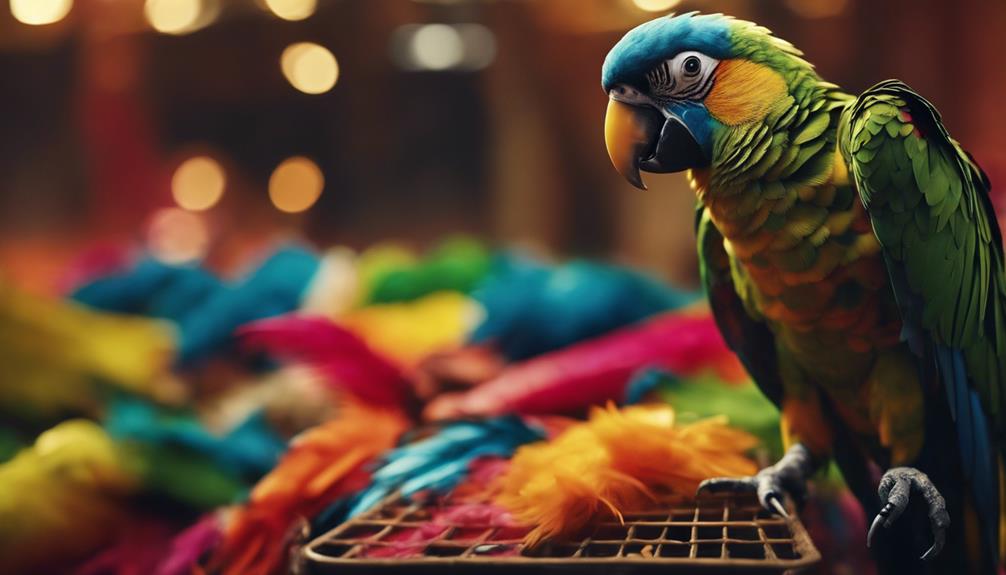
Illegal wildlife trade poses a significant threat to parrot species worldwide, impacting their populations and biodiversity. This illicit activity involves the illegal capture and trade of parrots for the pet trade, leading to severe consequences for these vulnerable birds. Conservation efforts are crucial in combating this threat, focusing on protecting parrot habitats, raising awareness, and promoting sustainable practices. Additionally, stringent law enforcement is essential to deter illegal wildlife traders and enforce regulations aimed at safeguarding parrot species.
| Conservation Efforts | Law Enforcement |
|---|---|
| Protecting habitats | Enforcing regulations |
| Raising awareness | Combating illegal trade |
| Promoting sustainability | Deterrence measures |
| Supporting sanctuaries | Monitoring illegal activities |
| Researching population dynamics | Prosecuting offenders |
Through a combination of conservation efforts and robust law enforcement, the impact of illegal wildlife trade on parrot species can be mitigated, ensuring a brighter future for these magnificent birds in the wild.
Pollution and Toxic Substances
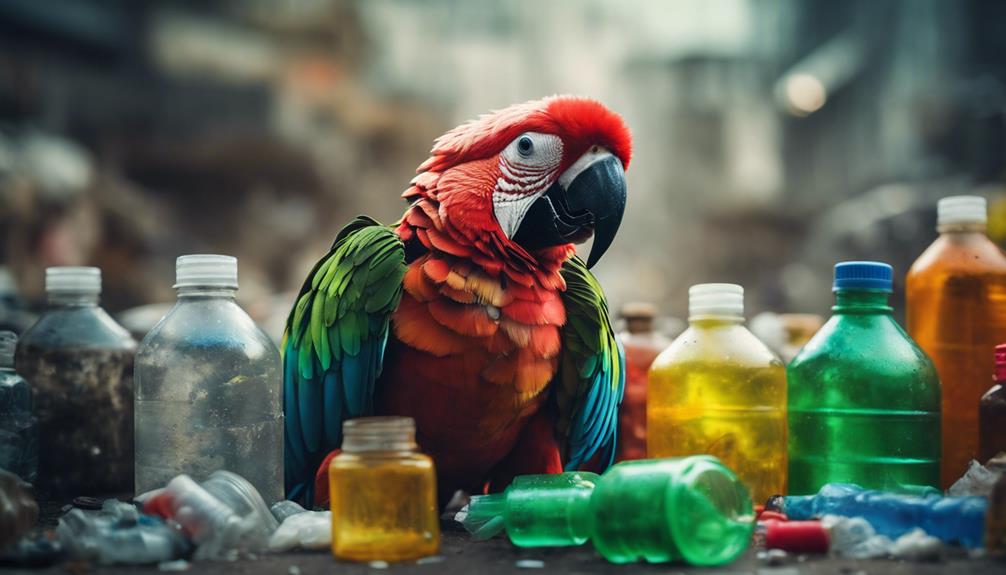
Chemical exposure can have detrimental effects on parrot species, impacting their health and reproductive success. Habitat contamination from toxic substances poses a significant threat to the survival of parrots, disrupting their natural behaviors and habitats.
Pollution not only affects parrots directly but also has cascading effects on the ecosystems they inhabit, leading to broader ecological imbalances.
Chemical Exposure Impact
Exposure to pollutants and toxic substances poses a significant threat to the well-being and survival of various parrot species worldwide.
- Pesticide exposure effects: Pesticides like organophosphates can lead to neurological damage in parrots.
- Industrial chemicals impact: Chemicals from industries can contaminate water sources, affecting parrots that rely on them.
- Heavy metal poisoning: Parrots are susceptible to lead and mercury poisoning from contaminated food sources.
- Air pollution effects: Inhaling pollutants like sulfur dioxide can harm parrots' respiratory systems.
- Chemical runoff contamination: Runoff from agricultural fields can introduce harmful chemicals into parrots' habitats, impacting their health.
Habitat Contamination Effects
How do pollution and toxic substances impact the habitats of parrot species globally? Water pollution and soil contamination pose significant threats to the well-being of parrot habitats. Water pollution, caused by industrial run-off, agricultural pesticides, and plastic waste, can contaminate freshwater sources crucial for parrot survival, leading to health issues and reduced food availability. Similarly, soil contamination from heavy metals, chemicals, and improper waste disposal can harm vegetation that parrots rely on for food and shelter. These contaminants can disrupt the delicate balance of ecosystems, affecting not only parrots but also other species within their habitats. It is crucial to address these issues through sustainable practices and conservation efforts to protect the diverse ecosystems that parrots call home.
| Effects of Pollution and Toxic Substances on Parrot Habitats | |
|---|---|
| Water Pollution | Reduced food availability and health issues for parrots |
| Soil Contamination | Harm to vegetation crucial for parrot survival |
Pollution on Ecosystems
Water pollution and soil contamination, as discussed in the previous subtopic, have profound implications for parrot habitats, highlighting the interconnectedness between pollution and ecosystem health. When considering pollution on ecosystems, specific threats emerge, including:
- Marine plastic: Accumulation of plastic debris in oceans poses a significant risk to parrots that rely on marine resources for food and nesting sites.
- Coral reefs: Pollution impacts coral health, disrupting the delicate balance of ecosystems where parrots forage and seek refuge.
- Air pollution: Contaminants in the air can affect parrots' respiratory health, leading to respiratory issues and decreased fitness.
- Toxic substances: Chemical pollutants in the environment can accumulate in parrot tissues, causing long-term health problems.
- Landfills: Improperly managed waste sites near parrot habitats can introduce toxins into the food chain, endangering these birds.
Invasive Species Competition
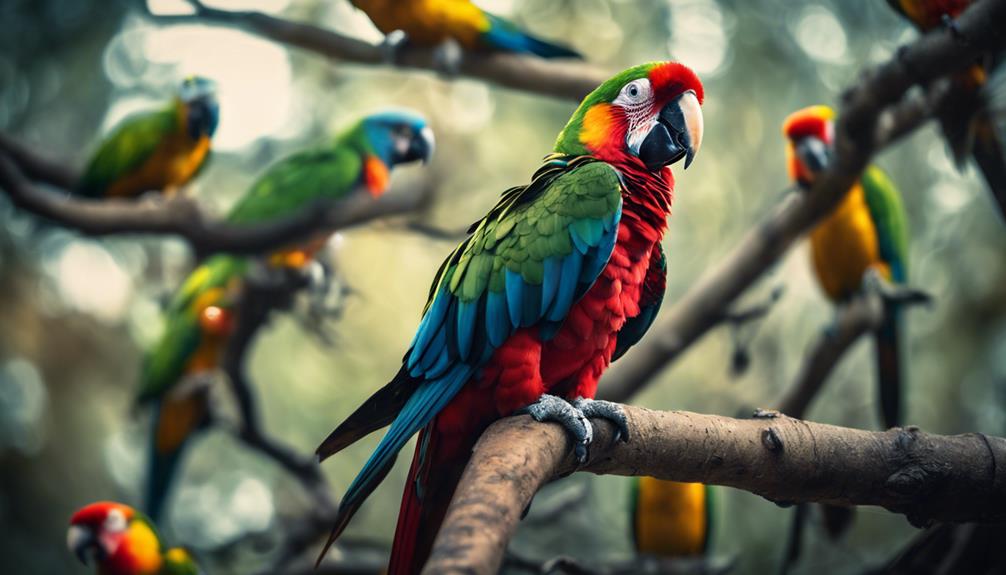
Invasive species pose a significant threat to parrot species by competing for limited resources such as food, nesting sites, and habitat. This competition can lead to decreased reproductive success, lower survival rates, and altered behaviors in parrot populations.
Understanding the impact of invasive species is crucial for developing effective conservation strategies to mitigate these threats and safeguard parrot species.
Invasive Species Impact
In ecosystems where invasive species compete with native parrot populations, the resulting impact can be detrimental to the survival and reproductive success of these avian species.
Invasive species can outcompete native parrots for resources like food and nesting sites. They may introduce new diseases and parasites that the native parrots aren't equipped to handle. Invasive species can also prey on native parrot eggs, chicks, and adults, leading to population declines.
The presence of invasive species can disrupt the delicate balance of the ecosystem, altering the availability of suitable habitats for parrots. Additionally, invasive species may change the behavior of native parrots, affecting their ability to find mates or raise offspring effectively.
Competing for Resources
The competition for resources between invasive species and native parrot populations poses a significant threat to the survival and reproductive success of these avian species. Resource scarcity intensifies this competition, affecting the social dynamics within parrot communities. Invasive species often outcompete native parrots for food, nesting sites, and other essential resources, leading to decreased reproductive rates and population declines among native parrot species. This ecological imbalance disrupts the delicate equilibrium within ecosystems, endangering the biodiversity and overall health of these habitats. Understanding the complex interactions between invasive species and native parrots is crucial for developing effective conservation strategies to mitigate the impact of resource competition on these vulnerable avian populations.
| Invasive Species | Native Parrots |
|---|---|
| Compete for resources | Struggle to survive |
| Disrupt social dynamics | Decreased reproductive success |
| Outcompete for food | Population declines |
| Impact biodiversity | Threaten ecosystem health |
Extreme Weather Events
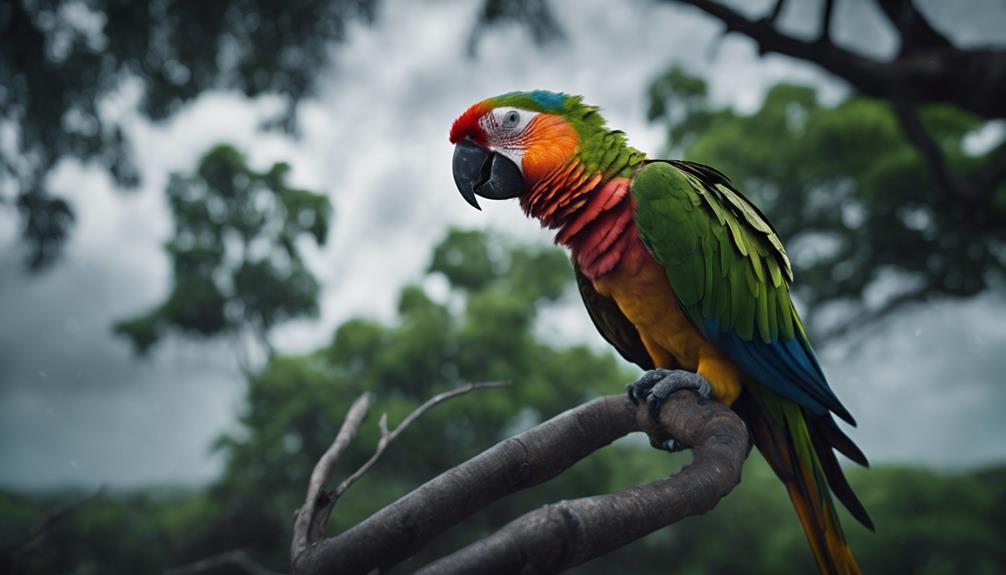
Extreme weather events like hurricanes and droughts significantly impact the habitats of parrot species, leading to population declines and habitat destruction. These events pose a serious threat to the survival of parrot populations due to:
- Nesting Disruptions: Hurricanes can destroy nesting sites, eggs, and young chicks, disrupting the breeding cycles of parrot species.
- Breeding Challenges: Droughts can lead to food scarcity, affecting the ability of parrots to breed successfully and raise their offspring.
- Food Scarcity: Extreme weather events can result in the loss of food sources for parrots, causing malnutrition and weakening the overall health of the population.
- Migration Disruptions: Parrot species that rely on seasonal migrations may face challenges in their regular patterns due to extreme weather events, impacting their ability to find suitable habitats.
- Habitat Destruction: Hurricanes and other extreme weather events can cause widespread destruction of forests and other habitats where parrots reside, leading to habitat loss and fragmentation.
Hunting and Poaching
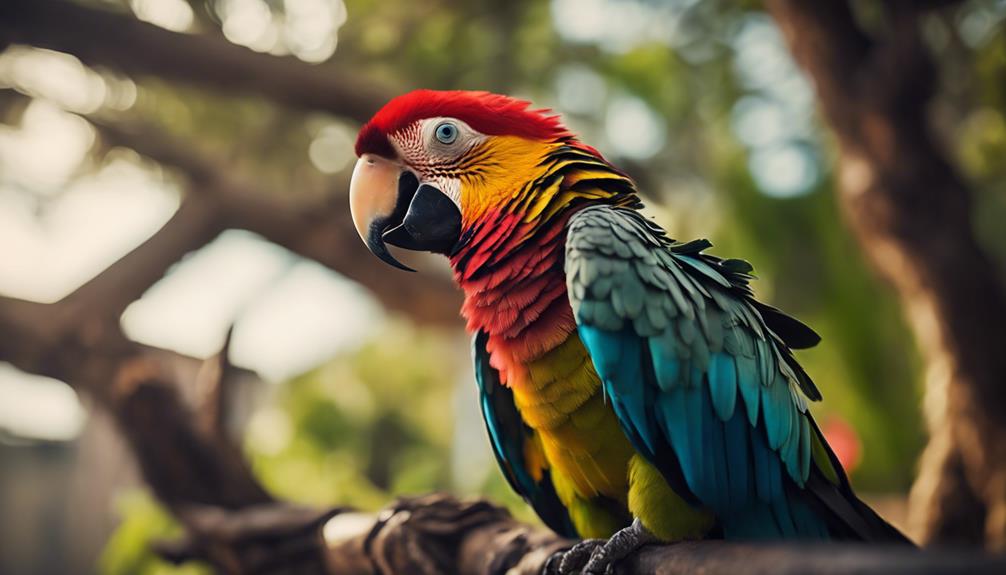
Hunting and poaching pose significant threats to parrot species worldwide, endangering populations and disrupting ecosystems. The illegal wildlife trafficking industry is a major driver of these activities, targeting parrots for their vibrant feathers, which are highly sought after in the pet trade and for decorative purposes.
Conservation efforts aimed at combating hunting and poaching play a crucial role in safeguarding parrot populations. These efforts include the establishment of protected areas, increased monitoring and enforcement to deter illegal activities, and community engagement to raise awareness about the importance of preserving parrot species.
Despite these measures, hunting and poaching continue to persist, driven by demand and lack of stringent regulations. To address this issue effectively, collaboration between governments, conservation organizations, and local communities is essential. By working together to tackle the root causes of hunting and poaching, we can strive towards a future where parrot species are protected and thriving in their natural habitats.
Frequently Asked Questions
How Do Parrots Specifically Adapt to Extreme Weather Events Compared to Other Bird Species?
Parrots adapt to extreme weather events by adjusting feather insulation and exhibiting behavioral changes. Their climate adaptation includes modifying nesting strategies to protect eggs and young. These unique adaptations help parrot species thrive in varying environmental conditions.
What Are the Long-Term Effects of Pollution and Toxic Substances on Parrot Populations?
Habitat loss and climate change impact parrot populations significantly. Pollution and toxic substances have long-term effects, affecting reproductive success and increasing disease susceptibility. Conservation efforts are crucial to mitigate these threats and ensure parrot species' survival.
Are There Any Specific Measures Being Taken to Combat Illegal Wildlife Trade That Target Parrots?
Are legal regulations effective in combating wildlife trafficking targeting parrots? Conservation efforts and enforcement measures aim to protect parrots from illegal trade. Strict enforcement and international cooperation are crucial to safeguarding these vulnerable species from exploitation.
How Does Invasive Species Competition Impact Different Parrot Species Differently?
Invasive species competition can impact parrot species differently due to variations in behavior and adaptation. Factors like resource availability and environmental changes influence how each species responds to competition pressures, affecting their survival and reproduction.
What Are the Ethical Considerations Surrounding Hunting and Poaching of Parrots for Cultural or Economic Reasons?
In considering hunting and poaching of parrots for cultural practices and economic incentives, it's vital to address the ethical complexities. Balancing tradition and commerce with conservation efforts is essential to ensure sustainable practices and protect parrot species.



